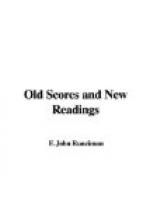I should not like to have to define the religious
beliefs of any man in Charles II.’s court, but
it would seem that Purcell was religious in his way.
He accepted the God of the church as the savage accepts
the God of his fathers; he wrote his best music with
a firm conviction that it would please his God.
But his God was an entity placed afar off, unapproachable;
and of entering into communion with Him through the
medium of music Purcell had no notion. The ecstatic
note I take to be the true note of religious art;
and in lacking and in having no sense of it Purcell
stands close to the early religious painters and monk-writers,
the carvers of twelfth century woodwork, and the builders
of Gothic cathedrals. He thinks of externals
and never dreams of looking for “inward light”;
and the proof of this is that he seems never consciously
to endeavour to express a mood, but strenuously seeks
to depict images called up by the words he sets.
With no intention of being flippant, but in all earnestness,
I declare it is my belief that if Purcell had ever
set the “Agnus Dei” (and I don’t
remember that he did) he would have drawn a frisky
lamb and tried to paint its snow-white fleece; and
this not because he lacked reverence, but because
of his absolute religious naivete, and because this
drawing and painting of outside objects (so to speak)
in music was his one mode of expression. It should
be clearly understood that word-painting is not descriptive
music. Descriptive music suggests to the ear,
word-painting to the eye. But the two merge in
one another. What we call a higher note is so
called because sounds produced by the mere rapid vibrations
make every being, without exception, who has a musical
ear, think of height, just as a lower note makes us
all think of depth. Hence a series of notes forming
an arch on paper may, and does, suggest an arch to
one’s imagination through the ear. It is
perhaps a dodge, but Handel used it extensively—for
instance, in such choruses as “All we like sheep,”
“When his loud voice” ("Jephtha"), nearly
every choral number of “Israel in Egypt,”
and some of the airs. Bach used it too, and we
find it—the rainbow theme in “Das
Rheingold” is an example—in Wagner.
But with these composers “word-painting,”
as it is called, seems always to be used for a special
effect; whereas it is the very essence of Purcell’s
music. He has been reproved for it by the eminent
Hullah, who prettily alludes to it as a “defect”
from which other music composed at the time suffers;
but the truth is, you might as well call rhyme a “defect”
of the couplet or the absence of rhyme a “defect”
of blank verse. It is an integral part of the
music, as inseparable as sound from tone, as atoms
from the element they constitute. But the question,
why did Purcell write thus, and not as Mozart and Beethoven,
brings me to the point at which I must show the precise
relationship in which Purcell stood to his musical
ancestors, and how in writing as he did he was merely
carrying on and developing their technique.




